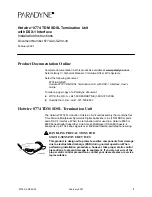
Glossary
GL-4
8000-A2-GB20-20
November 1997
A special purpose, dedicated computer that attaches to two or more networks and
forwards packets from one to the other.
A table that stores information about possible destinations for packets being routed
through the HotWire DSLAM and identifies the next hop address to which to send the
packet.
Remote Termination Unit. A device, such as the HotWire 5446 RTU, that is installed at the
end-user site (customer premises). The RTU connects to the local loop to provide
high-speed Internet or Intranet connectivity to the HotWire DSLAM.
Interface name of the card’s interface to the DSLAM system backplane bus.
Interface name of a DSL card’s DSL port #1.
Interface name of a DSL card’s DSL port #2.
Interface name of a DSL card’s DSL port #3.
Interface name of a DSL card’s DSL port #4.
Simple Network Management Protocol. A software program housed within a device to
provide SNMP functionality. Each agent stores management information and responds to
the manager’s request for this information.
A software program housed within a device to provide SNMP functionality. Each agent
stores management information and responds to the manager’s request for this
information.
A notification message to the SNMP manager when an unusual event occurs on a network
device, such as a reinitialization.
A permanent entry into the routing table that is manually entered. Static routes take
precedence over routes chosen by dynamic routing protocols.
A bit mask used to select bits from an IP address for subnet addressing. The mask is
32 bits long and selects the network portion of the IP address and one or more bits of the
local portion. This allows a subnet to be identified so that an IP address can be shared on
a LAN.
Transmission Control Protocol. An Internet standard transport layer protocol defined in
STD 7, RFC 793. It is connection-oriented and stream-oriented.
Transmission Control Protocol/Internet Protocol. The dominant protocol in the worldwide
Internet, TCP allows a process on one machine to send data to a process on another
machine using the IP protocol. TCP can be used as a full-duplex or one-way simplex
connection.
A simple remote terminal protocol that is part of the Transmission Control Protocol/Internet
Protocol (TCP/IP) protocol suite. Telnet allows the user of one host computer to log into a
remote host computer, and interact as a normal terminal user for that host.
Software that allows a session to work as if it was running a specific type of terminal; e.g.,
VT100 or 3270 to logically connect your terminal to a mainframe computer.
Trivial File Transfer application. A standard TCP/IP protocol that allows simple file transfer
to and from a remote system without directory or file listing.
A program that prints the path to a destination. It is a superset of the Ping utility used to
evaluate the hops taken from one end of a link to another.
In extended networks, the direction in which diagnostic messages flow from the final
tributary diagnostic modem to the intermediate links to the diagnostic control site.
See Authentication Server.
Router
Routing Table
RTU
s1b
s1c
s1d
s1e
s1f
SNMP
SNMP Agent
SNMP Trap
Static Route
Subnet Address Mask
TCP
TCP/IP
Telnet
Terminal Emulation
TFTP
TraceRoute
Upstream
XTACACS




































